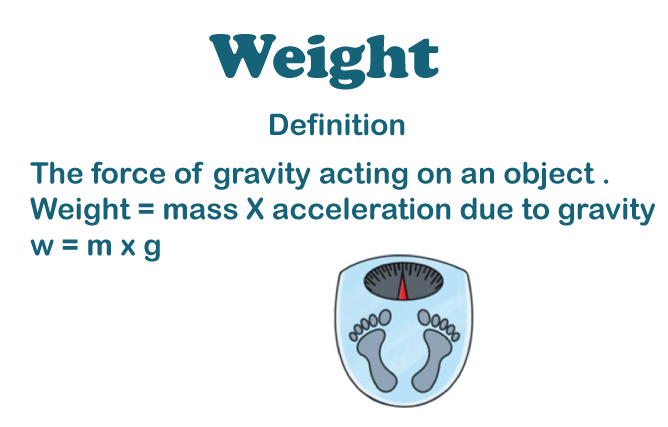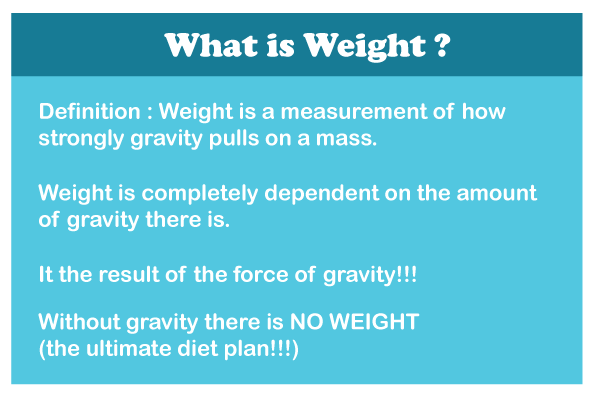Weight DefinitionWeight is typically used to describe how heavy an individual or an object is. In science, the definition is a little different. The force an object experiences due to gravity's acceleration is known as weight. Weight on Earth equals the mass times the gravitational acceleration (9.8 m/sec2 on Earth). The amount that anything weighs is known as the weight. Objects close to the Earth's surface are always affected by force. 
In science and engineering, an object's weight is correlated with the force exerted on it, which may be caused by gravity or another force holding it in place, and it is just the force that pulls a body toward the Earth. As a result, weight is a measure of an object's heaviness. Weight Measurement UnitsThe units of weight and mass are interchangeable in the US. The pound is the most often used weight unit (lb). Yet occasionally, the poundal and slug are used. The poundal is the force required to move a 1-lb mass at a speed of 1 ft/s2. The mass that accelerates at 1 ft/s2 when 1 pound of force is applied to it is called a slug. 32.2 pounds are equal to one slug. The units of weight and mass in the metric system are distinct. The newton (N), equal to 1-kilogram meter per second squared, is the SI unit of weight. It is the force necessary to accelerate a 1-kg mass at a speed of 1 m/s2. The dyne is the CGSS weight unit. The force required to move a mass of one gram at a speed of one centimeter per second squared is known as the dyne. 10-5 newtons make up one dyne. NewtonThe concept of weight underwent substantial additional development following the formulation of Newton's laws of motion and the creation of his law of universal gravitation. Mass and weight split apart. The weight came to be seen as the gravitational force acting on an object and, as such, being reliant on the object's context. In contrast, mass was defined as a fundamental attribute of objects tied to their inertia. Newton, in one instance, thought that weight was relative to another object exerting gravitational force, such as the Earth's mass in relation to the Sun. Newton believed that space and time were constant, allowing him to think about ideas like true position and velocity. Newton also understood that environmental elements like buoyancy impacted weight as determined by weighing. He referred to this as an apparent weight, different from the actual weight determined by gravity because it was a fake weight caused by inaccurate measuring conditions. 
Weight vs. MassWeight and mass can be confused easily, especially when using pounds! The amount of matter that makes up an object is expressed in mass, a quality of a substance that remains constant. The impact of gravity (or another acceleration) on an object is quantified by weight. Depending on the acceleration, the weight of a given mass might vary. For instance, while having the same mass on Earth and Mars, a person only weighs around one-third as much. Mass and Weight MeasurementBy contrasting an unknown amount of matter with a known amount of matter (a standard), mass is determined using a balance. There are two ways to measure weight. Measuring weight with a balance (in units of mass) is possible. Balances won't function, though, if gravity is absent. You should note that a 'calibrated balance' on the Moon would provide the same reading as on Earth. The spring scale or pneumatic scale is another tool for weighing objects. In order for a spring scale to offer a slightly varying weight for an object at two separate locations, this mechanism adjusts for the local force of gravity acting on an object. Scales are calibrated to provide the weight that an object would have at standard gravity. Commercial spring scales transferred from one site to another need to be recalibrated. Weight Variance All Over the GlobeIn different parts of the Earth, two variables affect weight. As the altitude rises, weight decreases because there is a greater distance between the body & the mass of the Earth. An individual weighing 150 pounds at sea level would equal 149.92 pounds at 10,000 feet above sea level. Latitude also affects weight. At the poles, a body weighs slightly more than it does near the equator. This is partially caused by the Earth's near-equator bulge, which moves items at the surface farther away from the center of mass. A contributing factor is that the centrifugal force in the poles differs from that at the equator because it acts perpendicular to the axis of the Earth's rotation.
Next TopicSolar System Definition
|
 For Videos Join Our Youtube Channel: Join Now
For Videos Join Our Youtube Channel: Join Now
Feedback
- Send your Feedback to [email protected]
Help Others, Please Share









